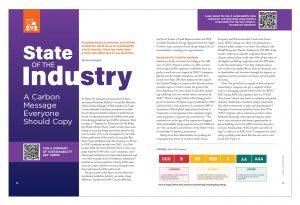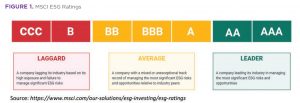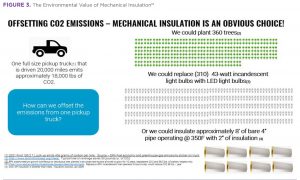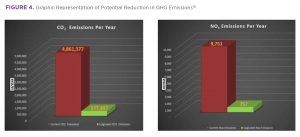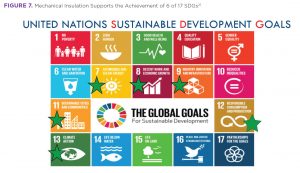State of the Industry: A Carbon Message Everyone Should Copy
As governments, businesses, and utilities around the world focus on sustainability and its benefits, there has never been a more rewarding time to use insulation.
At NIA’s 65th Annual Convention last October, association President David J. Cox and Joe Mlachak, National Sales Manager of NIA member Fit Tight Covers, delivered a luncheon presentation on how the mechanical insulation industry is perfectly positioned to help government and industry meet goals for reducing greenhouse gas (GHG) emissions. Their message in “Together for Tomorrow (As We Make the World a Better Place)” could not have been more timely, as every day brings more news related to the need to reduce CO2 in the atmosphere. In the weeks before publication of this article, for example, Rhodium Group published early data showing a 6.2% rise in GHG emissions last year over 2020.1 As of late January 2022, the United Nation’s Race to Zero campaign reported “1049 cities, 5,227 companies, 1,039 educational institutions, 441 financial institutions and over 3,000 hospitals from 52 healthcare institutions”2 involved in net zero initiatives. Clearly, GHG emissions are a topic of global concern, putting the issue front and center for 2022 and beyond.
The good news is that this is an area where the mechanical insulation industry can make a huge difference. I spoke with Dave Cox, Joe Mlachak, and Jacob Jordan (a Field Representative and NIA Certified Insulation Energy Appraiser with Fit Tight Covers) to get a picture of how the growing focus on sustainability is creating new opportunities.
Doing Good Is Good for Business
Industry is firmly on board. According to the Alliance of CEO Climate Leaders, one-fifth or more of the largest 2,000 companies worldwide have set goals to reach net-zero targets by 2050.6 Companies like Procter & Gamble, Salesforce, and HP have joined more than 200 other businesses who signed the Climate Pledge, an Amazon-led initiative whose members agree to work to reach the goals of the Paris Agreement 10 years ahead of schedule, including achieving “net zero annual carbon emissions by 2040.”7 There is strong evidence that doing good is good for business. A Nielsen report published in 2018 indicated that a clear majority of consumers (68% of Americans; 81% of global respondents) believed it “extremely or very important that companies implement programs to improve the environment.”8 The numbers rose as the age of the respondent dropped, with sustainability being a greater factor for Millennials—the consumers and investors of the future—than for members of previous generations.
Along those lines, shareholders are pushing the companies they invest in to reduce their carbon footprint, and Environmental, Social, and Governance (ESG) ratings can affect everything from a business’ public image to its credit. According to the World Economic Forum, “Analysis by UN PRI of the world’s 1,000 most valuable companies found that climate-related policy could wipe 43% off the value of the highest-polluting companies and add 33% value to the best performers.”9 Let that estimate sink in and consider the ripple effects, from the financial cost to shareholders and investors through the impacts on suppliers, partners, insurers, end users, and the global economy.
Dave Cox provided an example of how someone researching a company can get a snapshot of how well it is managing climate-related risks: the MSCI ESG rating. MSCI, Inc. gathers data on 35 ESG “Key Issues,” which vary based on industry and global industry classification standard, using a framework that allows assessment of risks and opportunities.10 Examples of environmental Key Issues (the “E” in “ESG”) include carbon emissions, product carbon footprint, financing environmental impact, water stress, toxic emissions and waste, opportunities in green building, and more. MSCI assesses the issues and uses Sustainalytics’ ESG research and risk ratings11 to arrive at an ESG score. Companies are rated using a grading scale much like the one used to rate bonds (see Figure 1).
On its website, MSCI is clear about the fact that these ratings serve one purpose only: i.e., to measure resilience to ESG risks relevant to financial well-being. MSCI stresses this is just one of many factors that affect financial risk. That said, would you prefer to invest in (or do business with) a leader or a laggard?
The market for such ESG information continues to grow. Along with the bandwagon of companies publicly pledging to reach carbon neutrality by a given date, we can expect to see more and more entities releasing information about their ESG efforts. The race is already underway: According to a report by the Governance & Accountability Institute, in 2019, 65% of companies in the Russell 1000 Index published information on their sustainability efforts, including 100% of those in the utilities sector and
90 companies in the industrial sector, and 90% of S&P 500 companies produced sustainability reports.12
Regulation and Legislation as Driving Forces
Right now, ESG reporting can seem like the Wild West. There are a host of different standards and frameworks to choose from. (You can read “ESG and Climate Impact Reporting” by double-clicking on the first image on this web page and scanning the QR code.) Different approaches and tools—coupled with varying interpretations of how to use them—mean that reporting by even the most well-meaning of companies can fail to provide the basis for an “apples to apples” comparison, much less an accurate aggregate assessment on the larger state of industry’s efforts. It is also easy for a company to talk a good ball game without actually doing much. This is enough a problem that there is a term for it: greenwashing (said to come from the term “whitewashing”).13 Greenwashing is when a company makes statements or provides misleading information to make it seem more environmentally conscientious than it actually is. It is often seen in the context of products advertised as being “green” without providing any real substantiation or details. Another example involves misdirection: A company that sells home improvement products publicizes its commitment to sustainable practices, encouraging customers to bring certain types of products to its stores to be recycled; yet, at the same time, it makes huge sums of money selling environmentally damaging merchandise.14
As a result, just as Environmental Product Declaration (EPD) and Life Cycle Analysis/Assessment (LCA) labels can help one identify products that have been vetted for environmental impacts using standardized methods, soon we can expect some level of standardization across sustainability reporting. The Securities and Exchange Commission (SEC) is expected to release a draft of new ESG reporting and climate disclosure requirements in the next few months, which should help level the playing field by setting standards for performance metrics and what data must be gathered, measured, and disclosed by public companies.
Legislation, too, increasingly plays a role. Dave Cox highlighted an example of particular relevance to the mechanical insulation industry: New York City’s Climate Mobilization Act of 2019, which includes a full slate of laws related to carbon reduction. Among these, Local Law 97 sets carbon-reduction targets for buildings over 25,000 square feet, including those summarized in Figure 2.
The writing is on the wall. In the near future, whether motivated by a drive to “do well by doing good” or because regulations or laws force them to do so (or some combination of both), everyone will in some way be affected by the need to reduce their carbon footprint, which represents a tremendous opportunity for anyone who designs, engineers, manufactures/supplies products, or provides services related to reducing carbon emissions.
The Power of Insulation—Save the Planet (while Saving Money)
This is where the story of Dave Cox’s truck enters the picture. Cox read the truck’s EPA sticker, which showed that the truck emits 406 grams of carbon per mile. He calculated what his truck emits in a year (using 20,000 miles/year as a baseline), then used the EPA’s Greenhouse Gas Equivalencies Calculator (https://www.epa.gov/energy/greenhouse-gas-
equivalencies-calculator) to get comparative values for other strategies for offsetting emissions. Against these figures, he added an estimate of the length of pipe that needed to be insulated to offset his emissions. Figure 3 summarizes the shocking results.
NIA has made the argument that “Insulation Is Greener than Trees” for more than a decade (see Christopher P. Crall’s January 2009 article and the September/October 2021 updated version published in this magazine at www.insulation.org/io/archives).
Cox connected with NIA member Joe Mlachak, National Sales Manager with Fit Tight Covers, a designer and fabricator of custom removable thermal insulation covers for industrial and commercial mechanical piping and equipment, who described how his company had recently performed an energy appraisal for a customer with “fairly aggressive” sustainability goals. Cox realized Fit Tight Covers’ appraisal and subsequent insulation project with the large, well-known pharmaceutical company is a solid case study in how the insulation industry can work with businesses and organizations seeking to meet carbon-reduction goals. The two men joined forces to explain the concept to others.
Insulation in Action: An Energy Appraisal Case Study
The customer is an international pharmaceutical company whose website details ambitious goals to eliminate GHG emissions from all its operations by the end of 2025 and achieve carbon-negative status by 2030. The company has an aging facility with complex piping systems supporting hot processes not far from Fit Tight Covers’ Midwest headquarters. This combination of factors made the plant a logical candidate to benefit from an energy appraisal.
The first step was a meeting with local plant personnel to gauge interest and buy-in to the global corporate initiative, and to explain how insulation could help reduce GHG emissions. It was clear from the meeting and subsequent facility walk-through that the customer was committed to taking action to reduce its global footprint and that there were opportunities for insulation to make a real difference.
Fit Tight Covers has several NIA Certified Insulation Energy Appraisers, including Mlachak and Jake Jordan, who assisted with gathering the data and preparing the report. Jordan identified 2,300 locations of missing and damaged insulation, all of which they cataloged in NAIMA’s 3E Plus® software. Use of the independent, third-party, industry-standard tool, along with the team members’ insulation energy appraisal certifications, gave the customer confidence in the process and results. As Mlachak notes, “they didn’t just have to take our word… It made the whole process more transparent.”
Collecting data for all the areas targeted for improvement was a painstaking process. Jordan recalls, “[The customer] said they wanted anything hot covered,” which included all plant steam, condensate, heating and process lines. Jordan entered all the data in 3E Plus, along with size measurements for each item, associated energy costs, and process temperatures. They also captured thermal images.
After the on-site investigation and subsequent work on the computer, the Fit Tight Covers team needed to partner with an insulation contractor to get labor costs for the insulation upgrades. Mlachak estimates the scope of work was about 70/30: 70% removable insulation and 30% conventional insulation. While his team was responsible for engaging the customer, conducting the appraisal, and manufacturing the blankets recommended in the solution, Mlachak says, “the contractor was a key piece to this puzzle.” Results of the appraisal are summarized in Table 1.
In this case, Jordan explains, given the customer’s ambitious carbon reduction goals, beyond the standard written report describing the appraisal process and providing results (including calculation of heat gain/loss, return on investment [ROI], payback period, emission reductions, etc.), Jordan prepared a full presentation for the plant personnel as well as corporate engineers and decision makers. As the team presented their findings, Mlachak says “The CO2 emissions savings was what they were after. You could see each of them having an ah-ha moment when we converted the dollars into emissions.” Figure 4 is an illustration of the “ah-ha”-inspiring data.
Mlachak notes that the EPA’s GHG Equivalencies Calculator—the same tool Dave Cox used in comparing carbon-reducing strategies to offset his truck’s emissions—helped them paint a clear picture for the customer of the value of the insulation upgrades (see Figure 5).
Mlachak says his personal favorite comparison is how the proposed insulation project was equivalent to the carbon sequestered by 4,000 acres of forest. As with the calculations using 3E Plus, use of a standard, third-party—in this case, U.S. Government—tool added legitimacy to the team’s results. The team also presented the numerous other benefits of the insulation project, including the following.
- Improved process control
- Reduced boiler usage
• Reduction in chemical treatment
• Reduced maintenance
• Improved lifespan - Improved working conditions for employees
• Reduced ambient temperatures
• Reduced ambient noise - Personnel protection
• Per OSHA Standard 1910.261(k)(11), all exposed steam and hot-water pipes within 7 feet of the floor or working platform, or within 15 inches measured horizontally from stairways, ramps, or fixed ladders, shall be covered with an insulating material or guarded in such manner as to prevent contact.
• Industry standard is to insulate anything at 140°F or more
The customer approved Fit Tight Covers’ proposal, and Jake Jordan is currently overseeing the project’s completion.
Key Takeaways
Mlachak says the key takeaways from the case study are applicable not just to how Fit Tight Covers is doing business, but for the entire mechanical insulation industry. As the number of companies with net zero goals continues to increase, the industry’s potential customer base grows with it. “Carbon is a new currency,” Mlachak notes, advising those doing energy appraisals to format their presentations accordingly for these customers, using the EPA’s GHG Equivalencies Calculator.
As your company gives thought to its own energy goals, it makes sense to think about insulation first. An energy appraisal, conducted by a Certified Insulation Energy Appraiser, can help identify opportunities like those Mlachak and Jordan found for their customer. Those in building and facility design/engineering also should turn to insulation experts for ways to build in (or retrofit) carbon and energy reduction as a value-added component of their services. In addition to fast tracking your GHG goals, everyone wants to save money and protect workers, which are benefits insulation has always offered. With ESG goals typically set at the highest corporate levels, you also may be able to reach back to a higher authority for help funding such projects.
Mlachak and Jordan stress that it is key to engage with the right customer contacts, which may mean reaching out to people in new roles, such as an Energy Manager, Energy Committee, or Owner. These decision makers and influencers will understand the project’s additional value beyond the dollars of energy savings. This can feel like unfamiliar territory to those accustomed to pitching insulation projects with the more traditional focus on insulation’s fast ROI. Mlachak and Jordan both note that the emphasis shifts when working with a company aiming to meet long-term sustainability goals. Asking questions and understanding these goals can help you develop a relationship in which you can be seen as a true partner or energy consultant. Jordan described how this unfolded in his work with the company in the case study. Originally, the customer sought information on just a small area. From the walk-through, though, and thinking of their ambitious carbon-reduction goals, Jordan identified other areas where energy savings could be achieved. He created a sample report based on the small area, as requested, but also explained that there were greater opportunities to reach their goals, including covering the hottest, largest pipes (which ran continuously). His consultation resulted in the customer expanding the scope of the appraisal and, ultimately, the project.
In addition to detailing GHG emissions reduction potential, energy loss can be shown dramatically in thermal images, which allow an appraiser to show heat loss instead of just telling the customer it is there (see Figure 6).
The Growth of Carbon Reduction Goals
First, a look at how the push to reduce carbon emissions has accelerated in just the last few years. Since the Paris Agreement was originally adopted in November 2016, more than 190 countries and the European Union have signed the international treaty, committing to reduce GHG emissions and collaborate on ways to mitigate the effects of climate change. Every 5 years, countries that signed the agreement produce a national climate action plan (called a National Determined Contribution, or NDC) detailing actions they will take to meet their commitment. In November of last year, at the annual Conference of the Parties, COP26, participating countries met to review progress made so far. Leading up to COP26, President Biden announced an update to the U.S. NDC that nearly doubles the country’s previous commitment, with a new plan to cut GHG emissions 50% from 2005 levels by 2030. Canada also is strengthening its NDC, increasing its previous target of 30% below 2005 levels to 40–45% lower emissions by 2030.3 Nearly half of all U.S. states, plus the District of Columbia, have GHG emissions targets,4 and 28 states have released a climate action plan.5 The bottom line is, places where readers of this magazine do business are increasingly focused on aggressive goals, and public- and private-sector entities alike will need to invest in technology and strategies like application of mechanical insulation to meet their targets.
“Stewards of the Planet”
In 2015, all member states of the United Nations adopted the 2030 Agenda for Sustainable Development, which “provides a shared blueprint for peace and prosperity for people and the planet, now and into the future.”20 The U.N.’s Sustainable Development Goals (SDGs) address all aspects of sustainability—from ending poverty and hunger to protecting the environment and achieving peace and justice. Figure 7 shows all 17 SDGs, with stars added to indicate those for which mechanical insulation can play a role.
As Joe Mlachak observes, supporting sustainability goes back to the concept of humans being “stewards of the planet.” Whether viewed from an ecological/environmental or theological perspective, the notion that we must take responsibility and care for our world is gaining traction. Those in the mechanical insulation industry can take pride in the knowledge that with all the benefits insulation offers, the work they do helps improve quality of life on the planet.
References
1. Alfredo Rivera, Kate Larsen, Hannah Pitt, and Shweta Movalia, “Preliminary Greenhouse Gas Emissions Estimates for 2021,” Rhodium Group, January 10, 2022. Accessed at
https://rhg.com/research/preliminary-us-emissions 2021/#:~:text=As%20a%20result%2C%20progress%20in,2025%20and%202030%20climate%20targets
2. Race to Zero Campaign Overview, accessed at
https://racetozero.unfccc.int/join-the-race/
3. David J. Cox and Joe Mlachak, “Together for Tomorrow (As We Make the World a Better Place),” presented at NIA’s 65th Annual Convention, October 25, 2021, slide #5. Presentation accessed at https://insulation.org/convention2021/presentations/
4. Center for Climate and Energy Solutions (C2ES), “U.S. State Greenhouse Gas Emissions Targets,” updated March 2021. Accessed at https://www.c2es.org/document/
greenhouse-gas-emissions-targets/
5. C2ES, “U.S. State Climate Action Plans,” updated October 2021. Accessed at https://www.c2es.org/document/climate-action-plans/
6. Abdul Latheef, Oil Price Information Services, “Voluntary Carbon Markets Poised for Growth in 2022,” reprinted with permission by Net-Zero Business Daily, IHS Markit Energy Expert, January 4, 2022. Accessed at https://cleanenergynews.ihsmarkit.com/research-analysis/voluntary-carbon-markets-poised-for-growth-in-2022.html
7. “Net Zero Carbon by 2040,” The Climate Pledge website, accessed at https://www.theclimatepledge.com/us/en
8. Sustainable Shoppers Buy the Change They Wish to See in the World: A Strategy Guide by Nielsen, Copyright © 2018, The Nielsen Company (US), LLC, page 18. Accessed at
https://www.nielsen.com/wp-content/uploads/sites/3/2019/04/global-sustainable-shoppers-report-2018.pdf
9. “Climate Action Platform—How the World Economic Forum Is Driving Climate Action,” World Economic Forum, July 2021, page 2. Accessed at https://www3.weforum.org/docs/
WEF_Climate_Action_Platform.pdf
10. “ESG Ratings Key Issue Framework,” MSCI website, accessed at https://www.msci.com/our-solutions/esg-investing/esg-ratings/esg-ratings-key-issue-framework
11. “ESG Risk Ratings: A Consistent Approach to Assess Material ESG Risk,” Sustainalytics website. Accessed at https://www.sustainalytics.com/esg-data
12. “2020 Flash Report Russell 1000® —Trends on the sustainability reporting practices of the Russell 1000 Index companies,” Governance & Accountability Institute, Inc., pages 3 and 10. Accessed at https://www.ga-institute.com/research-reports/flash-reports/2020-russell-1000-flash-report.html.
13. Will Kenton (reviewed by Margaret James), “Greenwashing,” Investopedia, January 23, 2021. Accessed at https://www.investopedia.com/terms/g/greenwashing.asp
14. Bruce Watson, “The Troubling Evolution of Corporate Greenwashing,” The Guardian, August 20, 2016, accessed at https://www.theguardian.com/sustainable-business/2016/aug/20/greenwashing-environmentalism-lies-companies
15. Cox and Mlachak presentation, slide 13.
16. Cox and Mlachak presentation, slide 15. NOTE: To see a video on the topic, go to https://vimeo.com/639933994
17. Cox and Mlachak presentation, slide 21.
18. Cox and Mlachak presentation, slide 22.
19. Cox and Mlachak presentation, slide 23.
20. “The 17 Goals,” from United Nations Department of Economic and Social Affairs Sustainable Development website. Accessed at https://sdgs.un.org/goals
21. Cox and Mlachak presentation, slide 8. Original UNgraphic available at website: https://sdgs.un.org/goals

